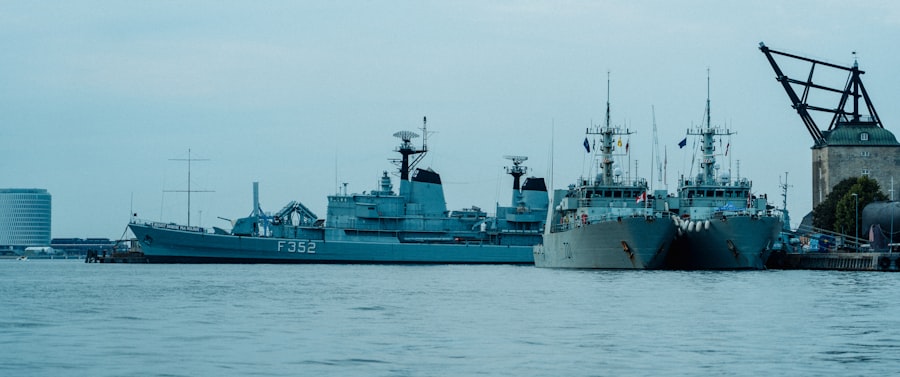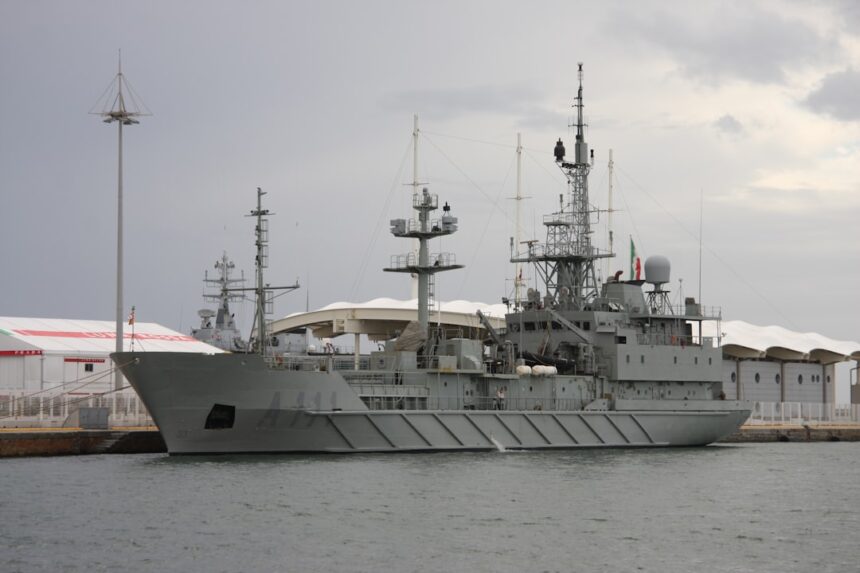In an era where technology permeates every aspect of military operations, the significance of cyber security for naval vessels cannot be overstated. As modern naval fleets increasingly rely on sophisticated digital systems for navigation, communication, and weaponry, the potential risks associated with cyber vulnerabilities have escalated dramatically. Cyber security is not merely an IT concern; it is a critical component of national defense strategy.
The integrity of naval operations hinges on the ability to protect sensitive information and maintain operational capabilities in the face of evolving cyber threats. Naval vessels serve as the frontline of maritime defense, often operating in hostile environments where the stakes are high. A successful cyber attack could compromise mission objectives, endanger personnel, and even lead to catastrophic failures.
The importance of safeguarding these assets extends beyond immediate operational concerns; it also encompasses broader implications for national security and international relations. As adversaries become more adept at exploiting technological weaknesses, the naval forces must prioritize cyber security to ensure their readiness and resilience in an increasingly complex threat landscape.
Key Takeaways
- Cyber security is crucial for naval vessels to protect against potential cyber attacks and ensure operational safety.
- Naval vessels are vulnerable to cyber attacks due to their reliance on interconnected systems and communication networks.
- Strategies for securing naval vessels from cyber threats include regular system updates, network segmentation, and access control measures.
- Encryption and authentication play a critical role in ensuring the integrity and confidentiality of data on naval vessels.
- Implementing firewalls and intrusion detection systems can help detect and prevent unauthorized access and malicious activities on naval vessels.
Vulnerabilities of Naval Vessels to Cyber Attacks
Naval vessels are inherently vulnerable to a range of cyber threats due to their reliance on interconnected systems. These ships utilize advanced technologies for navigation, communication, and weapon systems, creating multiple entry points for potential attackers. The integration of commercial off-the-shelf software and hardware can introduce additional vulnerabilities, as these components may not be designed with military-grade security in mind.
Furthermore, the complexity of these systems can lead to unintentional oversights in security protocols, making them susceptible to exploitation. Additionally, the human element plays a significant role in the vulnerabilities of naval vessels. Crew members may inadvertently expose systems to risks through negligent behavior or lack of awareness regarding cyber security best practices.
Phishing attacks, social engineering tactics, and insider threats can all compromise the integrity of a vessel’s cyber defenses. As naval operations become more reliant on technology, understanding and mitigating these vulnerabilities is essential for maintaining operational security and ensuring the safety of personnel and assets.
Strategies for Securing Naval Vessels from Cyber Threats

To effectively secure naval vessels from cyber threats, a multi-layered approach is essential. This strategy should encompass both technological solutions and human factors. First and foremost, implementing robust security protocols is crucial.
This includes regular software updates, vulnerability assessments, and penetration testing to identify and address potential weaknesses before they can be exploited by adversaries. Additionally, employing advanced threat detection systems can help monitor network traffic for unusual activity, allowing for rapid response to potential breaches. Moreover, fostering a culture of cyber awareness among personnel is equally important.
Regular training sessions that emphasize the significance of cyber security and best practices can empower crew members to recognize and respond to threats effectively. By integrating cyber security into daily operations and decision-making processes, naval forces can create a proactive environment that prioritizes the protection of critical systems. This holistic approach not only enhances the resilience of naval vessels but also ensures that personnel are equipped to navigate the complexities of modern cyber warfare.
Role of Encryption and Authentication in Naval Vessel Cyber Security
| Aspect | Importance |
|---|---|
| Data Encryption | High |
| Network Authentication | Critical |
| Communication Security | Essential |
| Access Control | Very High |
Encryption and authentication are foundational elements in the realm of cyber security for naval vessels. Encryption serves as a vital tool for protecting sensitive data transmitted across networks, ensuring that even if information is intercepted, it remains unreadable to unauthorized parties. By employing strong encryption algorithms, naval forces can safeguard communications between vessels and command centers, thereby maintaining operational integrity and confidentiality.
Authentication mechanisms further bolster security by verifying the identities of users and devices accessing critical systems. Multi-factor authentication (MFA) can significantly reduce the risk of unauthorized access by requiring multiple forms of verification before granting entry. This layered approach ensures that even if one credential is compromised, additional barriers remain in place to protect sensitive information.
Together, encryption and authentication form a robust defense against cyber threats, enabling naval vessels to operate securely in an increasingly hostile digital landscape.
Implementing Firewalls and Intrusion Detection Systems on Naval Vessels
The deployment of firewalls and intrusion detection systems (IDS) is essential for establishing a secure perimeter around naval vessels’ networks. Firewalls act as gatekeepers, monitoring incoming and outgoing traffic to prevent unauthorized access while allowing legitimate communications to flow freely. By configuring firewalls with strict rules tailored to the specific needs of naval operations, commanders can significantly reduce the risk of cyber intrusions.
Intrusion detection systems complement firewalls by providing real-time monitoring of network activity. These systems analyze traffic patterns to identify anomalies that may indicate a cyber attack in progress. When suspicious activity is detected, IDS can trigger alerts, enabling rapid response from cyber security teams.
The combination of firewalls and IDS creates a formidable defense against potential threats, allowing naval vessels to maintain operational continuity even in the face of cyber challenges.
Training Naval Personnel in Cyber Security Protocols

Training personnel in cyber security protocols is a critical component of any effective defense strategy for naval vessels. As technology evolves, so too do the tactics employed by cyber adversaries; therefore, continuous education is necessary to keep crew members informed about emerging threats and best practices. Regular training sessions should cover a range of topics, including recognizing phishing attempts, understanding social engineering tactics, and adhering to secure communication protocols.
Moreover, simulations and tabletop exercises can provide hands-on experience in responding to cyber incidents. By engaging personnel in realistic scenarios, they can develop critical thinking skills and learn how to react swiftly under pressure. This proactive approach not only enhances individual awareness but also fosters a collective responsibility for cyber security within the crew.
Ultimately, well-trained personnel serve as the first line of defense against cyber threats, significantly bolstering the overall security posture of naval vessels.
Collaboration with Government Agencies and Cyber Security Experts
Collaboration with government agencies and cyber security experts is vital for enhancing the resilience of naval vessels against cyber threats. By leveraging the expertise of specialized organizations, naval forces can gain access to cutting-edge technologies and intelligence that may not be available internally. Partnerships with agencies such as the Department of Defense (DoD) or cybersecurity firms can facilitate knowledge sharing and provide insights into emerging threats and vulnerabilities.
Furthermore, joint exercises and training programs can strengthen relationships between military personnel and cyber security professionals. These collaborative efforts foster a culture of continuous improvement and innovation in addressing cyber challenges. By working together, naval forces can develop comprehensive strategies that encompass both defensive measures and incident response protocols, ensuring that they remain prepared for any potential cyber attack.
Incorporating Cyber Security into Naval Vessel Design and Development
Incorporating cyber security into the design and development phases of naval vessels is essential for building resilient systems from the ground up. By integrating security considerations early in the design process, engineers can identify potential vulnerabilities and implement countermeasures before they become ingrained in operational systems. This proactive approach minimizes risks associated with retrofitting existing vessels with security features after deployment.
Moreover, adopting a “security by design” philosophy encourages collaboration between engineers, software developers, and cyber security experts throughout the development lifecycle. This interdisciplinary approach ensures that all aspects of a vessel’s operation are considered when addressing potential threats. As technology continues to evolve rapidly, embedding cyber security into vessel design will be crucial for maintaining operational effectiveness in an increasingly complex maritime environment.
Addressing the Challenges of Satellite Communication Security at Sea
Satellite communication plays a pivotal role in modern naval operations by enabling real-time data exchange between vessels and command centers. However, this reliance on satellite technology also presents unique challenges regarding security at sea. The vastness of maritime environments makes it difficult to monitor communications effectively, leaving vessels vulnerable to interception or jamming by adversaries.
To address these challenges, naval forces must implement robust encryption protocols specifically designed for satellite communications. Additionally, redundancy measures should be established to ensure continuity of operations in case primary communication channels are compromised or disrupted. By prioritizing satellite communication security, naval vessels can maintain situational awareness and operational effectiveness even in contested environments.
Response and Recovery Plans for Cyber Attacks on Naval Vessels
Having well-defined response and recovery plans is crucial for mitigating the impact of cyber attacks on naval vessels. These plans should outline clear procedures for identifying incidents, containing breaches, eradicating threats, and restoring normal operations. Establishing an incident response team composed of cyber security experts and key personnel ensures that there is a coordinated effort during a crisis.
Moreover, conducting regular drills simulating various types of cyber incidents can help refine these response plans over time. By testing their effectiveness in real-world scenarios, naval forces can identify gaps in their procedures and make necessary adjustments to enhance resilience against future attacks.
Future Trends and Innovations in Naval Vessel Cyber Security
As technology continues to advance at an unprecedented pace, future trends in naval vessel cyber security will likely focus on automation and artificial intelligence (AI). These innovations have the potential to revolutionize threat detection and response capabilities by enabling systems to analyze vast amounts of data in real time. AI-driven solutions can identify patterns indicative of cyber attacks more quickly than human operators alone could achieve.
Additionally, the integration of blockchain technology may offer new avenues for securing communications and data integrity within naval operations. By providing decentralized verification mechanisms, blockchain could enhance trust among various stakeholders involved in maritime operations while reducing vulnerabilities associated with centralized systems. In conclusion, as naval vessels navigate an increasingly complex digital landscape fraught with cyber threats, prioritizing robust cyber security measures becomes imperative for ensuring operational readiness and national defense integrity.
Through comprehensive strategies encompassing technology implementation, personnel training, collaboration with experts, and innovative design approaches—naval forces can fortify their defenses against evolving adversarial tactics while safeguarding critical assets at sea.
In recent years, the importance of cybersecurity for naval vessels has become increasingly critical as maritime operations rely more heavily on advanced technology and interconnected systems. A related article that delves into the intricacies of safeguarding naval assets against cyber threats can be found on the website “In The War Room.” This article provides insights into the latest strategies and technologies being employed to protect naval vessels from cyber attacks, ensuring the security and integrity of maritime operations. For more detailed information, you can read the full article by visiting In The War Room.
🔍WATCH THIS! The Secret Weakness That Will Break The US Military🧭
FAQs
What is cyber security for naval vessels?
Cyber security for naval vessels refers to the measures and protocols put in place to protect the electronic systems and data on board naval ships from cyber threats and attacks.
Why is cyber security important for naval vessels?
Naval vessels rely heavily on electronic systems for navigation, communication, and weapon systems. A cyber attack on these systems could compromise the safety and security of the vessel and its crew.
What are the potential cyber threats to naval vessels?
Potential cyber threats to naval vessels include hacking, malware, phishing attacks, and insider threats. These threats can disrupt operations, steal sensitive information, or even take control of critical systems.
How are naval vessels protected from cyber threats?
Naval vessels are protected from cyber threats through a combination of technical measures such as firewalls, encryption, and intrusion detection systems, as well as training and awareness programs for the crew to recognize and respond to potential threats.
What are the challenges in implementing cyber security for naval vessels?
Challenges in implementing cyber security for naval vessels include the complexity of the systems on board, the need for interoperability with other naval and allied systems, and the constantly evolving nature of cyber threats. Additionally, the maritime environment presents unique challenges such as limited bandwidth and connectivity.
What are some best practices for cyber security on naval vessels?
Best practices for cyber security on naval vessels include regular security assessments and audits, continuous monitoring of systems for unusual activity, regular training and drills for the crew, and collaboration with other naval and cyber security organizations.




